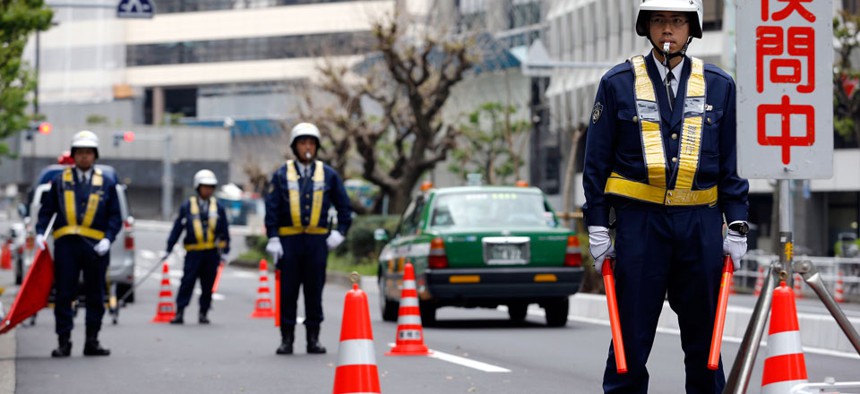
Policemen stand in front of the U.S. Embassy in Tokyo, Tuesday, April 22, 2014. Security has been increased in the Tokyo metro area a day before U.S. President Barack Obama arrives. Shizuo Kambayashi/AP
Obama Tries Once Again to Pivot Toward Asia
President Obama has begun a weeklong trip to Asia, attempting to continue an effort to step up the United States' presence in the region.
On Tuesday, President Obama will begin a weeklong trip to Asia, attempting to continue an effort he first announced nearly two and a half years ago to step up the United States’ presence in the region.
The president’s second-term efforts in Asia have taken a backseat to more pressing crises, such as those in Sudan and Ukraine, and legislative ones in Washington D.C. This week’s visit was initially scheduled for October, but the government shutdown threw a wrench in those plans. “The crisis of the day will always command the attention of the White House – and rightly so,” wrote Gideon Rachman in Financial Times.
In November 2011, addressing Australia’s Parliament, Obama said:
My guidance is clear. As we plan and budget for the future, we will allocate the resources necessary to maintain our strong military presence in this region. We will preserve our unique ability to project power and deter threats to peace. … Our enduring interests in the region demand our enduring presence in the region. The United States is a Pacific power, and we are here to stay.
Obama’s primary goal on this trip is to “rebalance” his relationship with the region, which according to National security adviser Susan Rice, involves “accessing new markets or promoting exports or protecting our security interests.” The Pacific region is also host to a number of ongoing tensions—North Korea and South Korea, China’s growing assertion of authority over territory that overlap’s with neighboring Japan and Taiwan.
The cornerstone of Obama’s Asia trip is the expected announcement on Monday of an agreement with the Philippines, allowing U.S. military to have extensive access to bases there. It would be the most substantial military presence since America relinquished its Subic Bay naval installation more than two decades ago.
Among other Department of Defense measures, according to Politico:
It’s forward-deploying two more Aegis Ballistic Missile Defense destroyers to Japan, to help guard against potential attacks by North Korea. It’s also sending Japan another missile defense radar. The Navy is planning to keep up a rotation of Littoral Combat Ships to Singapore.
The administration’s hopes for increased trade are tied to the Trans-Pacific Partnership, an agreement between twelve countries. But the Times notes that midterm elections in Congress make it far more difficult for the president to expedite authority for making trade deals, and without that other countries are unlikely to make similar concessions. The goal is to increase American exports to Asia substantially. Talks with Japan have been proceeding steadily, but will likely not open the floodgates to flourishing international trade. The U.S. and Japan are still apparently disagreeing over U.S. access to Japanese automobile and agricultural markets.






